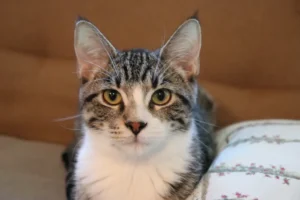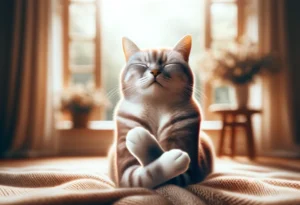Cats are known for their mysterious and sometimes quirky behaviors. One particular behavior that often leaves owners curious is why cats fluff their tails when they are happy. It’s a fascinating sight to see a cat’s tail puff up like a bottle brush when they are in a state of contentment. But what exactly is the reason behind this fluffy tail phenomenon?
When a cat fluffs its tail when happy, it’s a way for them to communicate their emotional state. The fluffy tail serves as a visual indicator that the cat is feeling relaxed, comfortable, and content. It’s a form of body language that helps them express their happiness in a non-verbal way. So, the next time you see your feline friend’s tail fluffed up, you can rest assured knowing that they are in a state of bliss.
Evolution of Tail Fluffing in Cats
Have you ever noticed your cat’s tail fluff up like a big cotton ball when they’re feeling especially happy? This behavior actually has deep roots in evolution. Back in the wild, when a cat is feeling content and secure in their environment, they would puff up their tail as a way to appear larger and more intimidating to potential threats. This instinctual response helped cats survive and thrive in the wild by warding off predators and asserting their dominance within their territory.
In the domestic setting, this behavior has carried over, but now it serves a different purpose. When your feline friend is fluffing their tail in your presence, it’s a sign that they feel comfortable, safe, and loved. It’s their way of showing you that they are content and happy in your company. So, the next time you see your cat with a fluffy tail, know that it’s a positive indicator of their emotional state.
Communication Through Tail Fluffing
Not only does tail fluffing serve as a physical display of happiness, but it also plays a crucial role in feline communication. Cats are known for their subtle body language, and their tails are a key part of this silent dialogue. When a cat fluffs their tail around their owners, it’s a way of strengthening their bond and expressing their affection.
Additionally, fluffy tails can also be a form of communication with other animals. When interacting with unfamiliar felines or creatures, a cat’s puffed-up tail signals their confidence and territorial boundaries. By understanding this behavior, pet owners can better interpret their cat’s feelings and facilitate harmonious interactions with other pets.
In summary, a cat’s fluffy tail is not just a cute physical trait but a powerful tool for both survival and communication. By recognizing and appreciating this behavior, pet owners can deepen their bond with their feline companions and create a more fulfilling and harmonious relationship.
Understanding Cat Behavior
Cats are fascinating creatures with a complex set of behaviors. When it comes to understanding why they fluff their tails when happy, it’s essential to consider their communication methods. Tail fluffing is a way for cats to showcase their emotions and communicate with those around them. It’s like their own form of body language.
In the feline world, a fluffy tail is often a sign of excitement or happiness. When your cat greets you at the door with a puffed-up tail, it’s their way of saying, “I’m so glad to see you!” This behavior is an instinctual reaction that dates back to their wild ancestors. In the wild, a fluffed-up tail can make a cat appear larger and more intimidating to potential threats.
While tail fluffing can be a positive sign, it’s essential to note that not all tail movements signify happiness. Cats also fluff their tails when they are scared, anxious, or feeling threatened. Understanding your cat’s overall body language and context is crucial in interpreting their tail fluffing accurately.
It’s essential to create a safe and comfortable environment for your cat to thrive and express their emotions freely. By paying attention to their tail movements and overall behavior, you can deepen your bond with your feline friend and ensure they feel secure and happy in their home.
The Role of Tail Fluffing in Social Interactions
When it comes to social interactions among cats, tail fluffing plays a crucial role in communication. Cats use their tails as a way to convey feelings and intentions to other felines. A puffed-up tail in a social setting can indicate excitement, confidence, or a friendly gesture.
In multi-cat households, you may observe cats fluffing their tails when engaging with each other. This behavior can signal playfulness, acknowledgment, or even submission. Understanding these social cues can help prevent conflicts between feline companions and promote a harmonious living environment.
What’s interesting is that cats also use tail fluffing as a means of communication with their human counterparts. When your cat fluffs their tail around you, they are likely expressing their comfort and trust in your presence. By reciprocating with gentle interactions and positive reinforcement, you can strengthen your bond with your feline companion.
Remember, every cat is unique, so it’s essential to observe and interpret their body language in the context of their individual personality and environment. By fostering a positive and nurturing relationship with your cat, you can cultivate a deeper understanding of their emotions and enhance the quality of your bond.
Signs of an Unhappy Cat
Have you noticed that your cat’s tail is puffed up like a feather duster? This could be a sign that your furry friend is feeling stressed or anxious. When cats are unhappy, they often exhibit this behavior to appear larger and more intimidating. Additionally, a tail thumping or thrashing can indicate annoyance or frustration. Keeping an eye on your cat’s tail movements can provide valuable insights into their emotional state. If you notice any of these signs, consider creating a calm and secure environment to help your cat feel more at ease.
Tips for Encouraging Tail Fluffing
Creating a joyful and harmonious space for your feline companion can encourage them to fluff their tails in contentment. To promote tail fluffing, ensure your cat has access to stimulating toys, cozy resting spots, and regular playtime. Providing a comfortable and clean litter box, along with nutritious food and fresh water, can also contribute to a happy cat. Setting aside quality time for cuddles and bonding can strengthen your relationship with your pet and promote tail fluffing as a display of happiness. Remember, a peaceful and loving atmosphere is key to a cat’s well-being.
- Maintain a consistent routine to establish a sense of security for your cat.
- Offer opportunities for exercise and mental stimulation through interactive play sessions.
- Incorporate vertical spaces such as cat trees or shelves for climbing and perching, which can enhance your cat’s environment.
- Ensure your cat has a designated scratching post to satisfy their natural urge to scratch and stretch.
- Regularly groom your cat to promote relaxation and bonding, which may lead to more tail fluffing moments.
Remember, understanding your cat’s individual preferences and providing a nurturing environment tailored to their needs can promote a happy and fluff-tailed companion. By implementing these tips, you can encourage your cat to express their joy through the delightful display of a fluffy tail.
Fun Facts About Cat Tails
Cat tails are more than just fluffy accessories – they play a crucial role in feline communication and balance. Did you know that a cat’s tail is composed of between 19 and 23 vertebrae, making it incredibly flexible? These tails can rotate a full 180 degrees, aiding in the cat’s graceful movements and nimble agility. Another fascinating fact is that a cat’s tail acts as a barometer for their emotions and intentions, with different tail positions signaling various moods. By paying attention to your cat’s tail, you can better understand their feelings and reactions.
Cat Tail Fluffing in Popular Culture
Cat tail fluffing is a common sight in various forms of media, serving as a visual cue for excitement, fear, or aggression. From iconic cartoon characters like Garfield and Tom from Tom and Jerry puffing up their tails in moments of comical chaos to internet memes showcasing cats with hilariously puffed tails, this behavior has been immortalized in popular culture. Next time you watch a cat video online or see a cartoon cat fluffing its tail, remember that this behavior reflects the feline’s emotional state and serves as a natural defense mechanism to appear larger and more intimidating.
Unleashing an even more unique insight, cat tail fluffing can also be influenced by the cat’s environment and interactions with humans. Research has shown that cats may fluff their tails not only in response to internal emotions but also as a way to communicate with their human companions. By recognizing this subtle form of communication, pet owners can engage with their cats more effectively and strengthen their bond.
Alex, a passionate animal lover, has experience in training and understanding animal behavior. As a proud pet parent to two dogs and three cats, he founded AnimalReport.net to share insights from animal experts and expand his knowledge of the animal kingdom.









